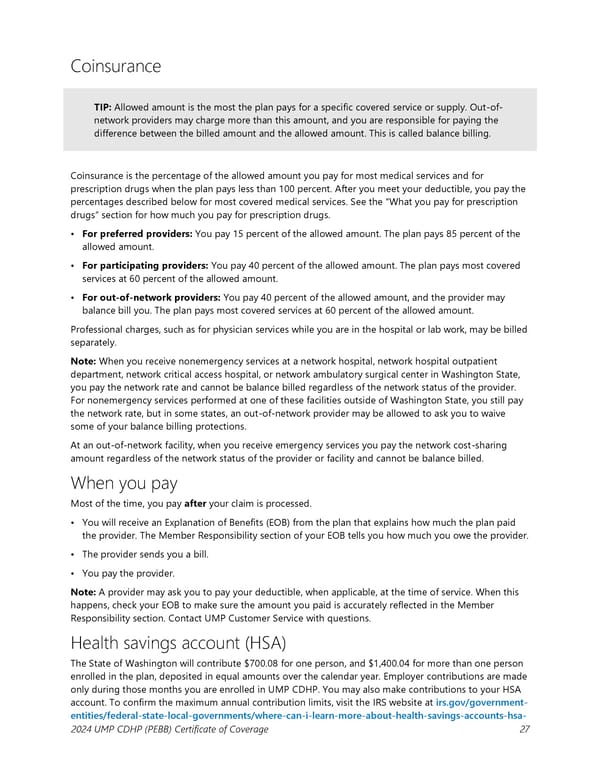Coinsurance TIP: Allowed amount is the most the plan pays for a specific covered service or supply. Out-of- network providers may charge more than this amount, and you are responsible for paying the difference between the billed amount and the allowed amount. This is called balance billing. Coinsurance is the percentage of the allowed amount you pay for most medical services and for prescription drugs when the plan pays less than 100 percent. After you meet your deductible, you pay the percentages described below for most covered medical services. See the “What you pay for prescription drugs” section for how much you pay for prescription drugs. • For preferred providers: You pay 15 percent of the allowed amount. The plan pays 85 percent of the allowed amount. • For participating providers: You pay 40 percent of the allowed amount. The plan pays most covered services at 60 percent of the allowed amount. • For out-of-network providers: You pay 40 percent of the allowed amount, and the provider may balance bill you. The plan pays most covered services at 60 percent of the allowed amount. Professional charges, such as for physician services while you are in the hospital or lab work, may be billed separately. Note: When you receive nonemergency services at a network hospital, network hospital outpatient department, network critical access hospital, or network ambulatory surgical center in Washington State, you pay the network rate and cannot be balance billed regardless of the network status of the provider. For nonemergency services performed at one of these facilities outside of Washington State, you still pay the network rate, but in some states, an out-of-network provider may be allowed to ask you to waive some of your balance billing protections. At an out-of-network facility, when you receive emergency services you pay the network cost-sharing amount regardless of the network status of the provider or facility and cannot be balance billed. When you pay Most of the time, you pay after your claim is processed. • You will receive an Explanation of Benefits (EOB) from the plan that explains how much the plan paid the provider. The Member Responsibility section of your EOB tells you how much you owe the provider. • The provider sends you a bill. • You pay the provider. Note: A provider may ask you to pay your deductible, when applicable, at the time of service. When this happens, check your EOB to make sure the amount you paid is accurately reflected in the Member Responsibility section. Contact UMP Customer Service with questions. Health savings account (HSA) The State of Washington will contribute $700.08 for one person, and $1,400.04 for more than one person enrolled in the plan, deposited in equal amounts over the calendar year. Employer contributions are made only during those months you are enrolled in UMP CDHP. You may also make contributions to your HSA account. To confirm the maximum annual contribution limits, visit the IRS website at irs.gov/government- entities/federal-state-local-governments/where-can-i-learn-more-about-health-savings-accounts-hsa- 2024 UMP CDHP (PEBB) Certificate of Coverage 27
 UMP Consumer-Directed Health Plan (CDHP) COC (2024) Page 27 Page 29
UMP Consumer-Directed Health Plan (CDHP) COC (2024) Page 27 Page 29